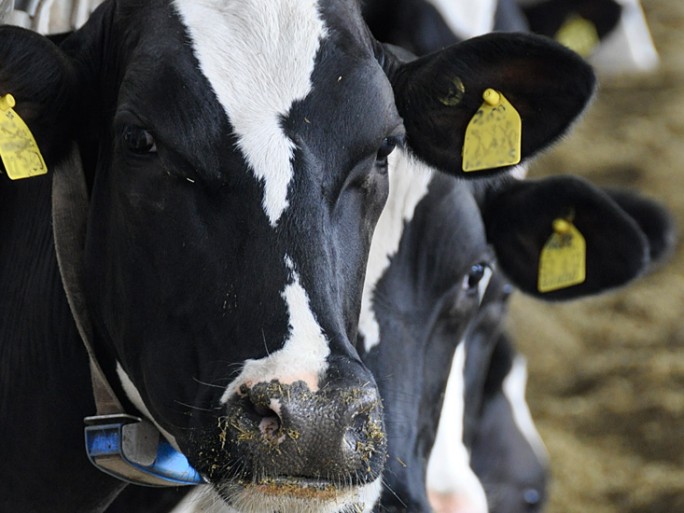Survey: Almost every second farmer uses AI

Four out of five farms say that digitalisation enables them to work in a more environmentally friendly way.
Whether for intelligent irrigation of fields, behavioural analysis of animals in the barn or data-based decision support during sowing – agriculture is on the brink of an AI revolution. Almost half of farms in Germany (47 per cent) are already looking into possible applications of AI.
One in ten farms (9 per cent) is actively using artificial intelligence, while a further 38 per cent are planning or discussing this. The larger the farm, the more intensive the involvement with AI: while only 27 per cent of farms with 20 to 49 hectares of land are using, planning or discussing the use of AI, the figure is 38 per cent among farms with 50 to 99 hectares and as high as 52 per cent among large farms with 99 hectares or more. These are the results of a representative survey of 500 agricultural businesses presented today by Bitkom and the German Agricultural Society (DLG).
‘Agriculture is one of the pioneers of AI and is ahead of most other sectors. AI can massively reduce the workload on farms, leaving farmers more time for other tasks. Smaller farms in particular should make greater use of the opportunities offered by AI,’ says Bitkom CEO Bernhard Rohleder.
Possible applications
The greatest potential for the use of AI in agriculture is seen in forecasting and crop protection, but also in office work: 54 per cent of farms that are already using, planning or discussing the use of AI do so for climate and weather forecasts, 36 per cent for market analyses or price forecasts, and 28 per cent each for harvest and production planning or yield forecasts.
46 per cent of farms that use, plan or discuss the use of AI want to improve crop protection, for example by diagnosing diseases, and 20 per cent want to improve health monitoring in livestock farming. But AI is also being planned, discussed or already used outside the barn and fields, with 4 out of 10 farms (39 per cent) using it for everyday office work such as administrative activities.
GPS-controlled agricultural machinery
Specifically, 91 per cent of farmers believe that digital technologies help to save fertiliser, pesticides and other resources. 69 per cent say they can contribute to improving animal welfare. 67 per cent say that digital technologies can help farms reduce costs in the long term and 60 per cent believe they can improve the quality of agricultural products. At the same time, digitalisation itself is a challenge for around half (54%) of farms.
The opportunities offered by digitalisation are increasingly being seized. Whether sensors, robotics or digital field catalogue, the use of digital technologies has fundamentally increased over the past two years: GPS-controlled agricultural machinery is the most widespread, with 69 per cent already using it. Two years ago, this figure was only 58 per cent. This is followed by digital field maps and cow or sow planners at 68 per cent (2022: 63 per cent). These are used to track breeding cycles in animal husbandry, among other things. Farm or herd management systems are now used by 46 per cent of farms, compared to just 32 per cent in 2022.
Only fertilise or spray as much as absolutely necessary: 36 per cent of farms already rely on applications for the site-specific application of fertilisers (2022: 30 per cent) or 30 per cent for the application of crop protection products (2022: 23 per cent). Sensor technology for animal husbandry and crop production is used by 28 per cent (2022: 22 per cent). Predictive maintenance, for example for agricultural machinery, is used by a quarter (25 per cent) (2022: 19 per cent). 24 per cent use automatic feeding systems or intelligent feeding systems (2022: 24 per cent). Drones are also used by just under a quarter (23 per cent), compared to 19 per cent in 2022. 12 per cent already use robotics (2022: 10 per cent). A total of 90 per cent of companies use at least one of these digital solutions.
Investment plans
19 per cent of companies plan to invest in digital technologies and applications this year. In 2023, 46 per cent of companies were already investing. In addition, 19 per cent are also planning digital investments in the coming year, with a third (33 per cent) planning to invest after 2025. Rohleder: ‘One-off investments are often not enough; technology must be maintained and software updated in order to maximise the benefits of the purchases. At the same time, investments in digital technologies pay for themselves quickly, and in the long term they also mean greater competitiveness.’
Financing is also a problem for agricultural businesses in view of the economic challenges: When asked about the strongest obstacles to the digitalisation of agriculture, most (75 percent) cite high investment costs. This is followed by concerns about more bureaucracy (61 per cent) and insufficiently standardised interfaces and networking of systems (59 per cent).
Farmers are rather dissatisfied with politics, giving the current political work on the digitalisation of agriculture an average grade of 4.7. Accordingly, half (52%) of farms complain about a lack of involvement in the planning of political measures. 51 per cent cite insufficient internet coverage as one of the biggest obstacles. This is followed by concerns about a loss of data sovereignty and the high complexity of digital systems, each at 49 per cent. 47 per cent are concerned about IT security and 41 per cent see a lack of digital skills as an obstacle.